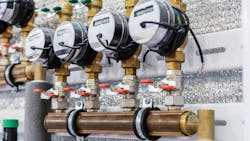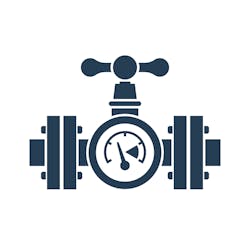How the IoT Can Help Prevent Legionnaires
While stopping the spread of COVID-19 is top of mind for many around the world, there are a number of other health threats that can stem from the pandemic period. For example, between shutdowns and social distancing orders, regular property maintenance may fall to the wayside, leaving spaces vulnerable to disease that can fester in the meantime.
As one example, during late September 2020, the UK’s Health and Safety Executive (HSE) released a bulletin that warned premises newly opening or re-opening after COVID-19 related lockdowns would need to be assessed for Legionella risk. For background, Legionnaires’ disease is a lung infection caused by legionella bacteria; it can kill an estimated 10% of those who contract it through complications associated with the infection. Unlike COVID-19, which is airborne, legionella bacteria are commonly found in water. The bulletin states, “If your building has been closed or had reduced occupancy during the coronavirus (COVID-19) pandemic, water system stagnation can occur due to lack of use, increasing the risks of Legionnaires’ disease.”
That risk isn’t limited to the U.K., though. The CDC has seen the number of cases of Legionellosis, which includes Legionnaire’s disease, increasing since 2000, with nearly 10,000 cases in the U.S. in 2018 alone—cementing it as a risk that event and building managers need to be aware of.
Thanks to preventative measures often required of facilities management and enforced by regulations such as the Health and Safety at Work Act (1974) and organizations such as the CDC, the legionella bacteria is not commonly found. However, when it does appear, it is most often due to non-compliance with health regulations, the presence of "dead arms," a water tube where the water stagnates, and/or prolonged non-use of the system or part of the system.
Therefore, outbreaks of Legionnaires’ disease, particularly in public buildings, hospitals, apartment blocks, colleges and other shared facilities can usually be prevented. One method of prevention is the careful monitoring of water supply, particularly domestic hot water (DHW) distribution networks. Facilities managers and property owners are obligated to conduct Legionella risk assessments, monitor networks and changes to DHW systems and pipework, identify sampling points and routinely test that minimum temperature requirements for storage, distribution and loop return for DHW are observed. The incubation period of Legionella is ten days in water between 70 and 115 °F. Traditionally, property managers would have to physically check and record water temperature measurements and glean potential health risks themselves. In addition to being highly involved, this process presents risk of exposure to those conducting it.
How the IoT Can Help Prevent Legionnaires
To make these preventative obligations more manageable, property managers can harness the power of the Internet of Things, or IoT. The IoT is a defined network of devises, such as temperature sensors, connected through software so that those devices can exchange data with one another, with that data filtered into an operator’s main dashboard. By deploying a network of connected devices instead of standalone units, operators can maintain insights into a variety of locations for whichever variables they intend to measure, such as water temperature.
IoT-connected temperature sensors, when attached to flow and return lines in hot water systems, can monitor the status of pipework, an installation and an entire premise in real time. Should water drop to low, or risky, levels or temperatures, connected alarms can be configured in smart monitored- and IoT-powered systems to instantly alert facilities managers that action needs to be taken.
When these sensors are connected to a network like 0G (a low-power, wide-area network that can transfer small amounts of data across long ranges), property managers can maintain continuous insights into water quality in a cost-efficient way and be notified of disturbances in real time. Easy to deploy and maintain, sensors and networks perform previously labor-intensive testing and measuring work and provide reliable analyses of probable risks present, allowing managers to safely and effectively monitor multiple properties at once.
While the frequency of measurement and data recording varies depending on the purpose of the establishment, IoT-enabled sensors offer users insights whenever they need them. Healthcare organizations, for example, are required to test more often, as are places of large-scale public gatherings, making the IoT an apt solution for procuring regular, health-critical insights.
Such technology is already being used to prevent Legionnaire’s. Idex, the first independent French energy services group, designs and installs sensors in at-risk places like cooling towers to measure temperature and energy consumption. This Legionella monitoring solution takes real-time readings of DHW pipe temperatures which feed into a dashboard that is accessed remotely. The use of such solutions and sensors, coupled with instantaneous notifications, means that premises can be quickly made safe before visitors and residents arrive or return. This considerably reduces the risk of developing Legionella bacteria in domestic hot water networks. This example of IoT fighting Legionella bacteria also champions a proactive approach for facilities managers, as it can also help them to exceed regulatory requirements.
The IoT Also Helps in Other Preventative Efforts
Not only can IoT connected devices and powered networks monitor water temperatures, but they can also measure humidity, energy consumption, gas or chemical levels within industrial environments. “Smart” buildings, where IoT devices monitor, measure and inform operators about comfort- and health-critical environmental factors, are safer for residents and workers, and are far more cost-efficient for building managers and owners. This is because, with up-to-date insights into key variables that could become hazardous to occupants, operators are privy to the knowledge needed to intervene before threatening situations escalate. As a result, property teams that invest in IoT technologies can save themselves from costly corrective maintenance down the line and, arguably more importantly, are empowered to protect health and safety throughout their spaces.
Investing in the IoT offers further benefits, such as monitoring rooms for efficacy and space needs, in addition to occupant and worker safety. For example, as many facilities are being managed by reduced or remote workforces for the time being, IoT-enabled sensors can be configured to building timeclocks so that managers can keep track of who is working and when to accommodate social distancing guidelines while ensuring any necessary maintenance is being completed. Additionally, IoT-connected dashboards can be deployed for occupant use (i.e., non-property employees) to input feedback that can direct operator’s priorities, thereby giving them an even more holistic view of their spaces.
A Solution for Legionnaires’ Disease and More
By using sensors to monitor conditions such as air quality and water temperature, building owners and office managers can quickly address problems as they arise. This monitoring can prevent sickness and severe harm and keep properties running at optimal conditions to avoid any unexpected reparations in the future. As owners and managers juggle the myriad of demands associated with upkeeping their buildings during the pandemic and beyond, the insights afforded by the IoT enable them to make more informed business decisions and operate resourcefully.
About the Author
Jeremy Prince
Jeremy Prince has been President of Sigfox USA since 2019. He previously joined the Sigfox corporate office, headquartered in France, as Chief Strategy Officer in 2018. In this role, he worked closely with Ludovic Le Moan, CEO and co-founder of Sigfox on key initiatives and the company strategy.

